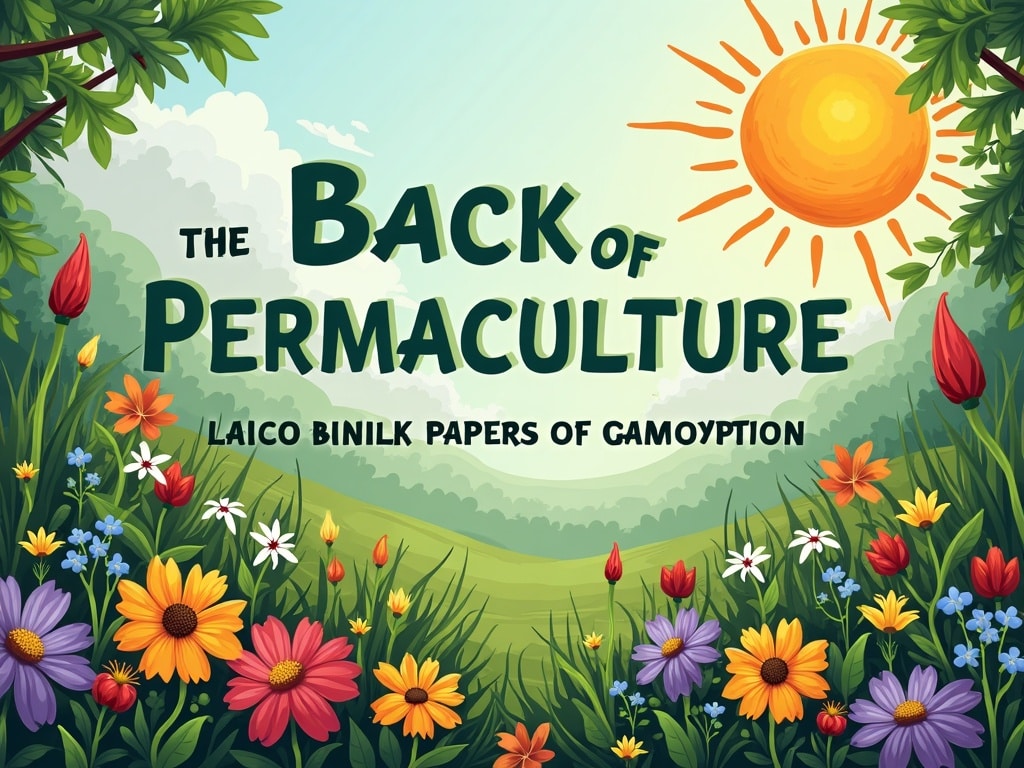Backyard Permaculture Ideas: Creating Your Sustainable Oasis
Imagine stepping into your backyard and finding not just a lawn, but a thriving ecosystem – a place where food grows abundantly, wildlife flourishes, and the whole space hums with life. That’s the promise of backyard permaculture. It’s about working *withnature, not against it, to create a self-sustaining and productive environment right outside your back door.
What is Permaculture?
Permaculture is more than just gardening; it’s a design philosophy. It’s a way of thinking about how we interact with the world around us, focusing on creating stable, resilient systems that mimic natural ecosystems. The word itself is a combination of permanent and agriculture, highlighting the goal of creating sustainable living systems that can thrive for generations.
At its heart, permaculture is guided by a set of core principles, including:
- Care for the Earth: Protecting and respecting natural resources.
- Care for People: Ensuring that people’s needs are met.
- Fair Share: Setting limits to consumption and redistribution of surplus.
These principles inform every design decision in a permaculture system, guiding us to create gardens, landscapes, and even communities that are both productive and ecologically sound. It’s about observing natural patterns, learning from them, and applying those lessons to create a harmonious and abundant environment.
Why Choose Permaculture for Your Backyard?
Why should you consider transforming your backyard into a permaculture haven? The benefits are numerous and far-reaching:
- Sustainability: Reduce your reliance on external resources and create a closed-loop system.
- Food Security: Grow your own fresh, organic produce, reducing your carbon footprint and ensuring access to healthy food.
- Environmental Benefits: Improve soil health, conserve water, and enhance biodiversity.
- Reduced Maintenance: A well-designed permaculture system requires less work over time.
- Increased Beauty and Enjoyment: Create a visually stunning and relaxing space that you’ll love spending time in.
Permaculture is about creating a win-win situation: a beautiful, productive space that benefits both you and the environment.
Backyard Permaculture Ideas: Getting Started
Ready to transform your backyard? Here are some practical ideas to get you started:
1. Observation is Key
Before you start digging, take the time to observe your backyard. Pay attention to:
- Sunlight: Where does the sun shine throughout the day?
- Water Flow: Where does water accumulate during rain?
- Soil Type: What kind of soil do you have (sandy, clay, loamy)?
- Existing Vegetation: What plants are already growing?
- Microclimates: Are there any areas that are particularly warm, cold, windy, or sheltered?
This observation period is crucial for understanding the unique characteristics of your site and designing a system that works *withthe natural conditions. Don’t rush this step!
2. Design with Zones and Sectors
Permaculture design often uses zones and sectors to optimize the placement of elements.
Zones
Zones are areas of the site, numbered 0-5, based on how frequently they are visited or managed:
- Zone 0: Your house – the center of activity.
- Zone 1: Areas visited most frequently, like herb gardens, vegetable beds, and compost bins close to the house.
- Zone 2: Areas visited less frequently, such as orchards, chicken coops, or beehives.
- Zone 3: Areas used for larger-scale food production or animal grazing.
- Zone 4: Semi-wild areas managed for foraging or timber production.
- Zone 5: Wild, unmanaged areas that provide habitat for wildlife.
Sectors
Sectors are external energies that influence the site, such as wind, sun, water, and fire hazards. Understanding these sectors helps you position elements to take advantage of beneficial energies and mitigate harmful ones.
3. Build Healthy Soil
Healthy soil is the foundation of any successful permaculture system. Focus on building soil fertility by:
- Adding Compost: Compost is decomposed organic matter that enriches the soil with nutrients and improves its structure.
- Using Cover Crops: Cover crops are plants grown to protect and improve the soil. They can add organic matter, fix nitrogen, and suppress weeds.
- Mulching: Mulch is a layer of organic material that helps retain moisture, suppress weeds, and regulate soil temperature.
Avoid synthetic fertilizers and pesticides, which can harm soil life and disrupt the natural balance of the ecosystem.
4. Implement Water Harvesting Techniques
Water is a precious resource. Implement water harvesting techniques to capture and store rainwater for later use:
- Rain Barrels: Collect rainwater from your roof gutters.
- Swales: Dig shallow ditches along the contour of your land to capture and infiltrate rainwater.
- Rain Gardens: Create sunken areas planted with water-loving plants to absorb rainwater runoff.
By capturing and storing rainwater, you can reduce your reliance on municipal water and create a more resilient landscape.
5. Plant Guilds: Companion Planting on Steroids
A plant guild is a group of plants, animals, and other organisms that work together to support each other. A classic example is the apple tree guild, which might include:
- Apple Tree (Central Element): Provides fruit and shade.
- Nitrogen-Fixing Plants (e.g., Clover): Enrich the soil with nitrogen.
- Dynamic Accumulators (e.g., Dandelions): Bring nutrients up from the subsoil.
- Insectary Plants (e.g., Yarrow): Attract beneficial insects that control pests.
- Ground Cover (e.g., Strawberries): Suppress weeds and provide ground cover.
Plant guilds create a more resilient and productive ecosystem than planting species in isolation.

6. Introduce Animals (If Possible)
Animals can play a valuable role in a permaculture system. Consider adding:
- Chickens: Control pests, provide eggs and meat, and fertilize the soil.
- Ducks: Control slugs and snails, and provide eggs and meat.
- Bees: Pollinate plants and produce honey.
Make sure to provide appropriate housing, food, and water for your animals.
7. Vertical Gardening
If you have limited space, consider vertical gardening techniques:
- Living Walls: Create vertical gardens on walls or fences.
- Trellises: Grow climbing plants like beans, cucumbers, and grapes on trellises.
- Hanging Baskets: Hang baskets of herbs, vegetables, and flowers.
Vertical gardening allows you to maximize your growing space and create a visually stunning feature.
8. Embrace Diversity
Diversity is key to a resilient permaculture system. Plant a variety of plants, attract a variety of insects, and encourage a variety of wildlife. The more diverse your ecosystem, the more resilient it will be to pests, diseases, and other challenges.
9. Natural Pest Control
Avoid synthetic pesticides and herbicides. Instead, use natural pest control methods:
- Attract Beneficial Insects: Plant insectary plants to attract beneficial insects that prey on pests.
- Use Companion Planting: Plant certain plants together to deter pests.
- Handpick Pests: Remove pests by hand.
A healthy, balanced ecosystem will naturally regulate pests.
10. Compost, Compost, Compost!
Composting is essential for closing the loop in your permaculture system. Compost kitchen scraps, yard waste, and other organic materials to create a nutrient-rich soil amendment.
Common Mistakes to Avoid
Starting a permaculture garden can be exciting, but it’s easy to make mistakes. Here are a few common pitfalls to avoid:
- Not Observing Enough: Rushing into planting without understanding the site.
- Ignoring Zones and Sectors: Placing elements in the wrong location.
- Neglecting Soil Health: Planting in poor soil without addressing the underlying issues.
- Overworking the Soil: Tilling too much and disrupting the soil ecosystem.
- Using Synthetic Chemicals: Harmful to soil life and overall ecosystem health.
- Lack of Planning: Not having a clear design in mind.
- Giving Up Too Soon: Permaculture takes time and patience.
Long-Term Maintenance and Evolution
A permaculture system isn’t a one-time project; it’s an ongoing process of observation, adaptation, and refinement.
- Regular Observation: Continue to observe your system and make adjustments as needed.
- Weeding and Pruning: Keep weeds under control and prune plants regularly to encourage growth and productivity.
- Adding Compost and Mulch: Continue to build soil health by adding compost and mulch.
- Experimenting: Try new plants, techniques, and approaches.
- Enjoying the Process: Permaculture is a journey, not a destination. Enjoy the process of learning and connecting with nature.
The Future of Your Backyard
Transforming your backyard into a permaculture oasis is an investment in a more sustainable and fulfilling future. By working with nature, you can create a beautiful, productive space that benefits both you and the environment. So, get out there, start observing, and begin your permaculture journey today! The rewards – fresh food, a thriving ecosystem, and a deeper connection with nature – are well worth the effort.
